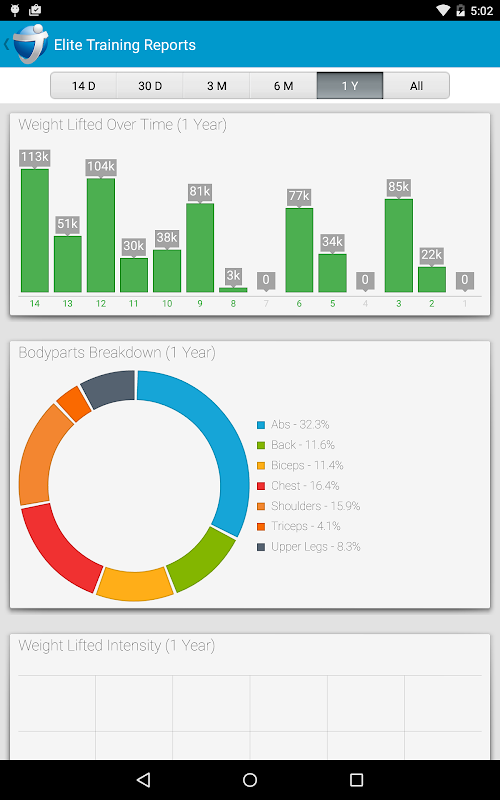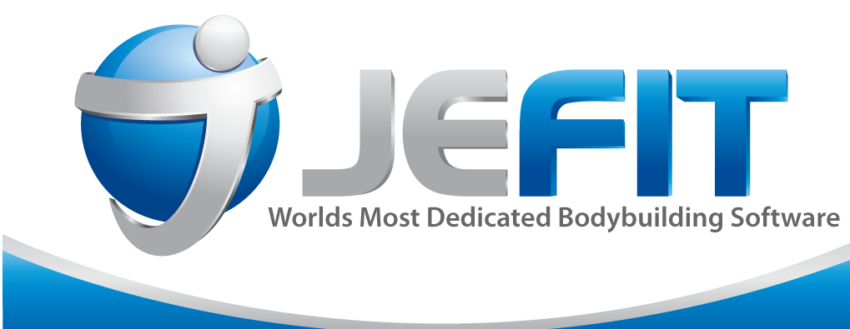Product / Service Brief
JEFIT is a workout tracking application, it provides over a thousand individual workouts and allows users to log and track their exercise routines. In addition to providing individual exercises for veteran users, the app also provides numerous training programs and provides progress reports for the individual user. In conjunction with the workout program, it provides mini clips with each exercise so users can verify they are doing a given exercise correctly and provide a user with alternative exercises that lets them modify their workout to overcoming common users like plateauing.
On added bonus in addition to the day to day interactions is that the fully paid version of the app provides reports, visual graphs, along with weekly and monthly email reports on what the users have achieved. This is helpful for users to see if they are overdoing one or more muscle groups more than the others or help them concentrate on strengthening a weak muscle group while maintaining others. In essence, enabling them to “sculpt” their body.
My Take on the app and use cases
As many of you can relate, I was looking to start working out again after being off the bandwagon for the past couple of decades. I came upon this app via one of my many feeds and figured I would try it out to motivate and guide me to start a routine in sculpting my body.
There are a countless number of workout apps available to users, but once I got back on the “workout bandwagon” and started populating the data, it made it next to impossible for me to move to another solution. Since there is no standard format in workout data, and the various apps do more provide an easy method to import or export that data would mean that I would have to copy over a year’s worth of workout data from one app to another manually. From an app provider perspective, this strategy makes complete sense in why they would not make it easy to lose customers. You can also argue that introducing changes to a user that has built the momentum in working an app would interrupt or even stop that trend.
I am a workout veteran who has been working out on and off since my high school days. One key feature that has me committed to this is the app has the ability for me to find new exercises as well as the ability for me to add new ones to my local library. What this feature does is help prevent boredom and plateau scenarios with my workouts as well as take advantage of new routines I see and learn from other folks at the gym and from my social network. And to be honest, some days you just don’t feel like doing one type of workout so it’s nice to have options.
There are lots more features that I necessarily don’t use but knowing how others work out to provide the app the flexibility to be tailored to a high degree.
My Use Case:
- Go to my local NYSC with an overall theme in mind, (i.e. upper / lower vs back & chest / biceps / tricep / shoulder, etc..)
- Look through the list of workouts
- Review my history on what was the most recent weights and reps I did for that exercise. Most days I would look to go up in weight or reps this time around
- Complete my set & log it in the app
- Once I am done with my whole work out I take a screenshot of my logs and share it via WhatsApp workout group
Something to solve for
FEATURE: Enhance Sharing
One key factor that can help users stay committed to working out is having a group that incentivizes and encourages each other to continue one’s progress. This can be observed in the market with the adoption of wearable and step tracking. We have seen huge adoption of groups getting together to challenge each other on who does the most to stay healthy.
As important as it is to build a community on your platform, the app should not restrict the user from sharing various aspects of their workout so users that are signed up to it. There are over 8,000 apps around health & fitness, each various from UI / UX to features available to users. So users have a choice to pick one that meets their needs even if it’s something simple as aesthetics. In such an ecosystem expecting users to sign up to your app to partake in the social aspects is not viable.
- Screenshot or link to the page of their detailed workout logs via any modality the device provides. (i.e. SMS, MMS, WhatsApp, FB Post, Hangouts, Skype, Vibe, etc..)
- Receiving user can review the workout and even click on it to learn how to do that particular workout itself (at this point you can prompt the user to join the community since they see value in the info the app can provide and convert them to a user)
Images share of any of the progress reports via modality of users choice:

From a market & feature parity, there are other workout apps in the market like Strava who provide the ability to share aspects of a users progress via the users preferred messaging/social service. Strava, for instance, will share the image of the map as well as enable the target user to see a breakdown of the specific activity.
FEATURE: Support for variations in equipments, metrics, etc…
In my line of work traveling is a good portion of being a technology evangelist. As much as I love what I do it becomes a challenge when trying to get into a routine. For the majority of the trips I am staying in various hotels which have varying degrees of amenities for their guests. I have been in places which has one treadmill to a full-fledged gym that can compete with my NYSC near my home. That being said a study in 2017 noted that only around 22% of guests use the gym on average.
Workout equipment vendors who provide equipment to these hotels vary from one hotel to another even if they are in the same chain. The outcome of this discrepancy is that various excursions equipment design can vary. For instance, the design of a tricep machine provided from one vendor vs another can change the amount of weight you can effect. This can happen for everything from how the machines dictate the posture to how the weights are distributed through the various pulleys and how the resistance calculated. So this presents a challenge when it comes to keeping track and making sure I am achieving the metrics I want. Now also consider that this can apply to non-travelers as well as people do switch gyms, move to home gyms, and other scenarios.
- Provide the user to build gym profiles and catalog the equipment they use
- When a user starts their workout they should have the option to select their default gym or add another one. The next time the user goes to that location the app will default to that profile.
- If the app does not have any information, images, or workout videos for the equipment at that location, it can encourage the user to take pictures of the equipment which can then later be verified and added to the DB for other users to leverage.
- Potential business development opportunities to partner with the hospitality industry to help add value to the amenities they offer and drive up the usage. One example could be by tailoring notifications to users to workout and what to work out when they get to that location.
- Crowdsource gym profile data aggregated to provide an intelligent experience
- Leveraging technologies like Computer Vision, Machine Learning & Artificial Intelligence can be used to recognize equipment and present appropriate data.
- For instance, it can recognize the make & model of the equipment which it can then look up instruction videos on youtube or the vendors’ site
- By encouraging and enabling users to provide data relevant to this market provides.a stickiness factor as well as an incentive for users to join or expand their community on the platform
- Once the data is gathered the app can be intelligent and present the user a workout plan that is in line with their routine and customize to the machines available
- In cases where there are data discrepancies, the systems can analyze the users’ workout history to recommend the correct settings to use on the new equipment or normalize the weight measurements that let users see an accurate measurement of their progress. This provides a reliable way for users to target and pass milestones.
- Leveraging technologies like Computer Vision, Machine Learning & Artificial Intelligence can be used to recognize equipment and present appropriate data.
Quick view metrics
- App URL
- https://www.jefit.com/
- App Developer
- https://www.jefit.com/
- Available Platforms
- Web App
- Android
- iOS
- Patent Status:
- Unknown but possible
- Feature available somewhere else
- Sharing feature available on other apps in this space
- TAM Scope: (based on 2017 report)



